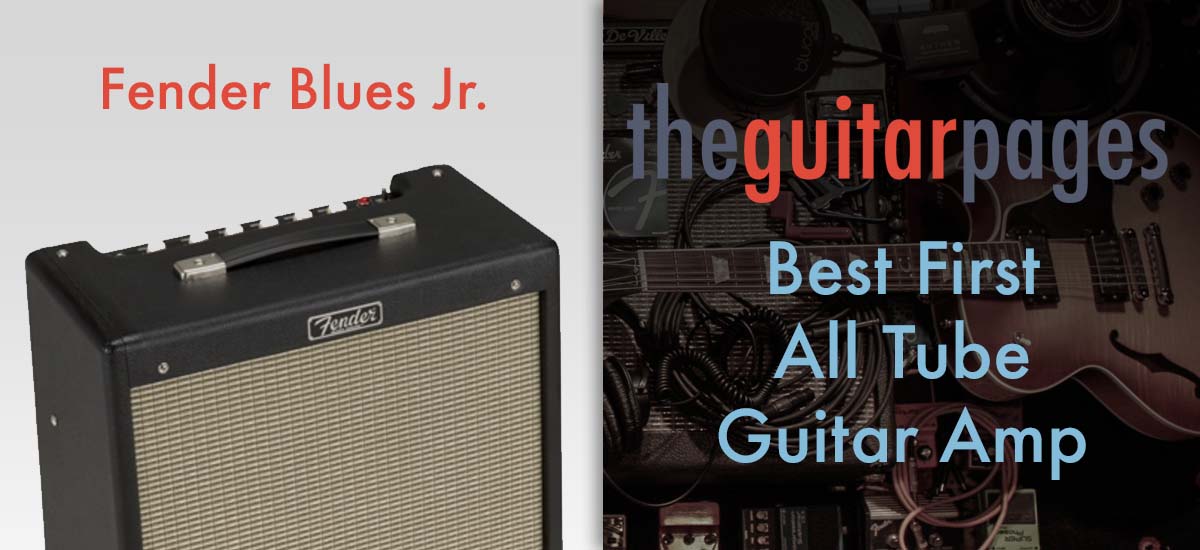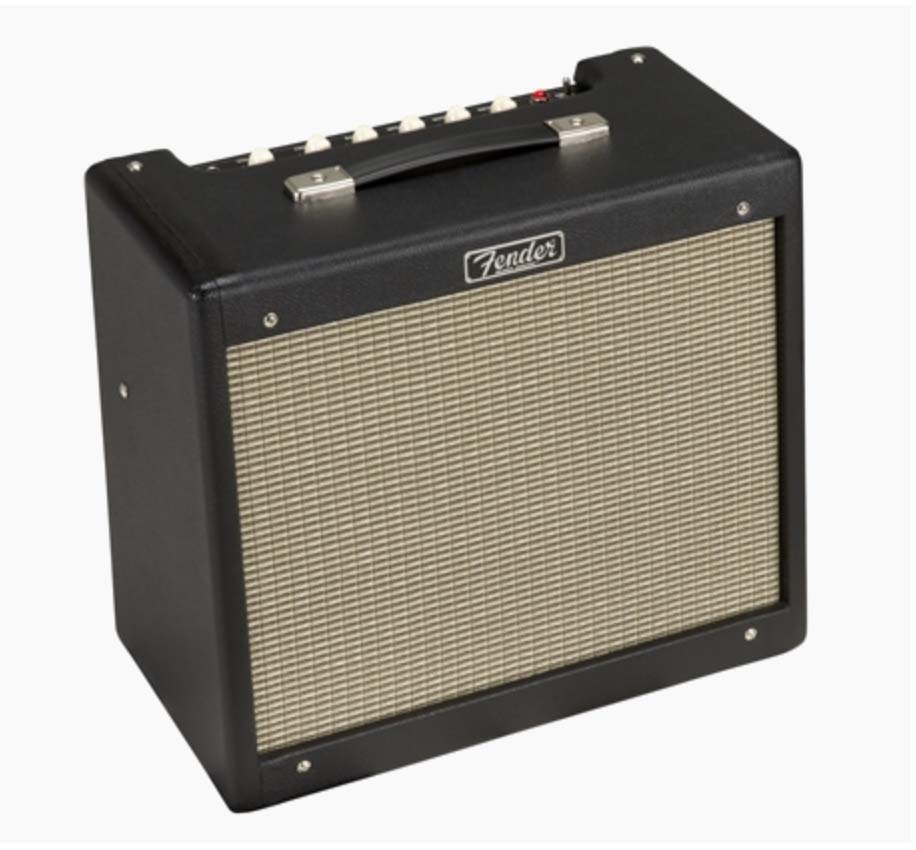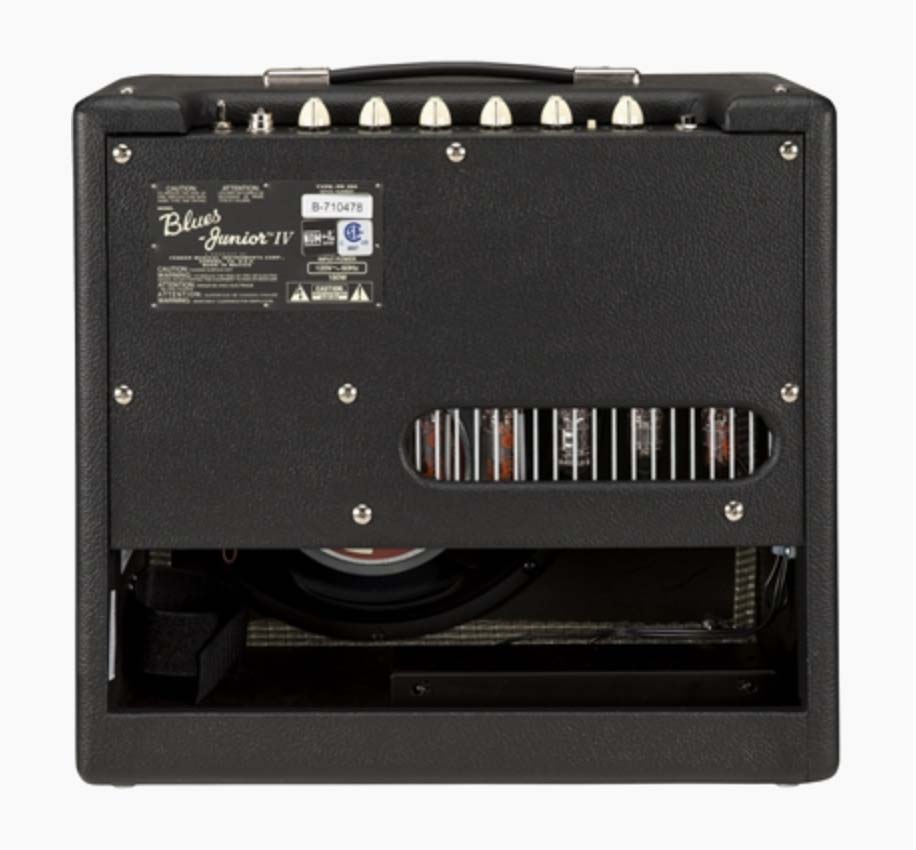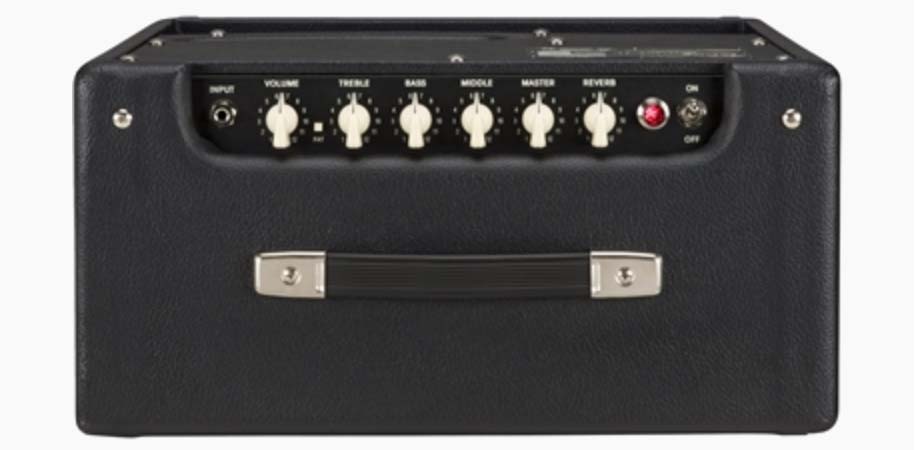The first all tube guitar amp that you should buy is the Fender Blues Jr. This is such a versatile, great sounding amp that is perfect for practice, gigs, hauling to and from practice, and using with your favorite effects pedals. Every guitar player progresses up to a tube amp at some point, and when that time comes for you the Fender Blues Jr will not disappoint.
The 5 reasons why you should buy the Fender Blues Jr. are:
- Great price for an all tube amp
- It’s an incredibly versatile amp and handles all genres well
- Lightweight and easy to pack around
- Beautiful sparkly Fender all tube tone with the perfect amount of power
- Iconic Fender amp with comprehensive warranty
Fender Blues Jr. IV, Check Price on Amazon
Best All Around Guitar Tube Amp
The Fender Blues Jr is one of the greatest small tube amp combos ever made. I understand that is a bold statement, but it sounds awesome with nearly every guitar, every effects pedal, weighs a fraction that most amps do, has plenty of power, and is affordable to boot. While any piece of gear is generally a series of compromises in order to highlight certain strengths, the Blues Jr. excels in almost every category.
Fender released the Blues Jr. in 1990 and it’s been a staple of their tube amp lineup ever since. It’s goal was to reach the warm, tube-driven tone of rock and roll music while keeping two important characteristics: affordability, and portability.
Blues Jr. IV Specifications
- 15 watts
- Celestion 12″ A-Type speaker
- Preamp circuit modified for increased fullness
- Spring reverb modified for improved smoothness
- Includes 1-button footswitch for FAT mid boost
- Single ¼” input
- 31.5 lbs (14.3 kg)
- Tubes: Preamp 3 – 12ax7, Power 2 – EL84
Versatility
As mentioned, the Blues Jr. has a very nice warm tube tone that you’d expect out of a Fender tube amp. This lends itself nicely to clean guitar tones, overdriven guitar tones, and anything else an effects pedal will throw at it.
I’ve used this amp for playing jazz, and for playing blues and rock. This amp has a master volume knob as well as a volume knob. What’s the difference?
The Volume knob on the far left controls the volume of the first preamp stage. This passes along a certain amount of signal to the rest of the amp. The Master volume knob controls volume in what’s called the power section of the amplifier.
This allows for the natural overdriven distortion of the amp to be generated in the amp circuit and then controlled before it goes out to the power tubes. In simple terms this means that you can get natural tube distortion at lower volumes.
Weight
For most people, weight isn’t the first feature of an amp that they look for. And realistically, if you don’t plan on playing gigs or practicing at different locations, basically moving an amp around a bunch, then a heavier amp isn’t an issue.
The first tube amp that I bought was not great for packing around. In fact, it was this behemoth: the Fender DeVille 2×12. That’s a 60 watt amp that weighs 53 lbs. And boy do you feel every single pound of that 53. The amp is big, bulky, and awkward carrying up and down stairs.
Not exactly the amp you want to be packing to and from band practice every week.
The Blues Jr. weighs in at only 31.5 lbs. More than 20 lbs lighter than the DeVille, and in a much more compact size, the Blues Jr is easy to pack in and out, week in and week out.
While most guitar players (especially younger ones) won’t think much of an amps weight, after countless hours of hauling a monster amp around, this is now a major consideration for me. The Blues Jr. is the perfect weight and size for the guitar player who has band practice on a weekly basis, or is playing frequent gigs.
Power
The Blues Jr. uses 2 EL84 power tubes to get 15 watts of power. For most uses this is a perfect wattage. If you’re not super familiar with wattage ratings, it’s important to note that the perceived loudness of a tube amp is considerably louder than a similarly rated solid state amplifier. While a 15 watt solid state is pretty quiet and only really is good for practice, a 15 watt tube amp is a viable option for small live gigs and playing with a drummer.
I have used this amp extensively for practice with a full band, drums, bass, and a horn lineup. I never had issues with this amp not being loud enough.
I have used this amp live, in a packed venue, with a full blues band.
The Blues Jr is is a killer amp that provides enough power for most situations. If you play loud heavy metal, or jazz then consider a different amp. For heavy metal, you’ll want an amp that crunches a bit more in its distortion, and something a bit louder. For jazz you’ll want more clean headroom than this amp provides.
What is “headroom”?
Headroom describes the amount of clean volume or power an amp provides before distortion, or tube saturation starts to occur. For certain types of music, like jazz, you want as much clean volume as possible. The Fender Blues Jr is an awesome amp, but doesn’t have a ton of headroom.
This is actually a good thing for most types of music. The real warm overdrive occurs when a tube amp is cranked up nice and loud. Running a Blues Jr. above halfway on the volume results in a nice buttery overdrive that is perfect for soul, funk, blues, and rock. Any more power, and it’s really difficult to get the amp loud enough to reach that perfect overdrive.
Price
The Fender Blues Jr. is $599.99. This is the beginning of the tube amp price range which goes from about $600 on up to $3000 or $4000. Considering an all tube circuit, with both gain and volume knobs, and a true spring reverb, this really is a great deal.
While you can manage to find some all tube amps for a little bit cheaper, they certainly won’t have the range that the Blues Jr. does. A used Vox Night Train can be found for under $300, but it’s really a one trick pony that does dirty blues great, and that’s about it.
Tubes
The Blues Jr. uses three 12ax7 tubes in the preamp. If you’re wondering what the difference between 12ax7 tubes and ecc83 tubes are, the answer is nothing. They are the exact same tube, 12ax7 typically being an American designation and ecc83 being a British one.
These are great tubes, and incredibly common in Fender preamps. If you want to play with the tone a bit, get some 12at7 (ecc81) tubes and swap those out. They are a lower output tube, and often decrease excess gain in the front end of the amp. If you really like that mellow tube sound, this can be a great, cheap modification.
tubes tubes tubes tubes tubes tubes
The power tubes are a pair of matched EL84s which bring the output up to 15 watts. This is a different set of power tubes than Fender normally would use in their amps like the more common 6L6 or 6V6 power tube. Furthermore, this is a common tube for British amp makers like Marshall to put in their amps. So why doesn’t the Blues Jr. have that punch midrange of a British rock amplifier?
The EL84s end up complimenting the Fender preamp circuit nicely and maintaining the shimmery sparkle of the Fender clean sound, while packing a buttery overdriven punch when turned up.
How long do tubes last in the Fender Blues Jr.?
Tubes will last anywhere from 3 months to decades. Typically amp companies will warranty their amps for much longer than the tubes are covered. Tube lifespan depends on physical roughness, how hot the amp is being played, how often it’s being played, and sometimes you just get lucky with a pair of tubes and they last forever.
The Blues Jr. that I’ve played the most never had it’s tubes replaced. I’ve also had to replace power tubes within 6 months because they started to make excessive noise or went cold. It’s not like an oil change, there is no need to change tubes on an amp unless the tubes go bad.
How much does it cost to replace the tubes on the Blues Jr.?
You would probably never replace all of the tubes on the amp at one time, but if that was the case, 3 JJ 12ax7s (Amazon) and 2 JJ EL84s (Amazon) comes to only about $63.60. Since tube replacement is a rare occurrence, I don’t factor in tube costs when considering buying an amp.
Blues Jr. III vs Blues Jr. IV
What is the difference between the Blues Jr. III and the Blues Jr. IV. Until recently, the III has been the latest and greatest in this line of amps, and I honestly didn’t see any areas where they could improve.
Fender looked deep though and changed up a couple things in the Blues Jr. The circuitry has received a slight tweak giving the amp a more responsive lower end, keeping the bass tight and full. And the speaker has been upgraded to the Celestion A-Type.
These differences are a nice upgrade, but I wouldn’t sell your III to go out and pick up a IV. An important factor of owning a tube amp is the break-in process. Like a good acoustic guitar top, a tube amp with its wood cabinet and paper speaker have a break-in period as well. A little tube amp you play for 10 years is going to blow any new amp out of the water, no matter what circuit changes they make to it.
Don’t Buy a Hybrid Tube Amp
A hybrid tube amp is a guitar amp that has a tube preamp, or a partial tube preamp, and a solid state power section. Hybrid amps are sold as “get that tube sound without the tube hassle.” But are these claims realistic? No. Very much no.
When you hear about warm tube tone, it’s often talked about hand in hand with overdriven tones, or saturation. What is saturation? Saturation is an electrical state that occurs in the tube itself when the amp is being pushed hard (the volume is turned up). The tubes can no longer amplify the signal in a clean manner resulting in distortion. Almost all of the “warm tube tone” that comes out of a tube amp is a result of the power tubes, not the preamp tubes.
Because of that, hybrid tube amps really just cut out the best parts of a full tube amp, sticking a solid state power section on the end resulting in an amp that is just barely better, if at all, than a fully digital solid state.
There’s certainly a time and place for digital effects and modeling, but don’t try to sell it as true tube tone. That’s just misleading.
How can you tell if an amp is hybrid or full tube?
- Check if the amp has two switches: Most tube amps have a power switch and a standby switch. The power switch allows the heaters in the tubes to start warming up, and the standby switch allows the signal to make it all the way to the power tubes. Because a hybrid tube amp doesn’t have a tube power section, there won’t be a standby switch.
- Check the amp’s weight: The power section of a tube amp requires a decently sized output transformer which takes a signal of high volts, low amps and turns it into the low volts, high amps with which the speaker can then recreate your guitar sound. Most OT’s (output transformers) aren’t especially light, so check the weight of the amp. If it’s surprisingly light, then you most likely have a hybrid tube amp of some sort.
- Take a Peek in the Back: The power tubes in most amps can be seen from the back, so just take a look and see what’s back there. Be careful if the amp is on, those tubes get hot! Most tube amps will have pairs of power tubes that clearly go together. These will look significantly different than the small preamp tubes.
And of course you can always rely on the manufacturer to tell you. Many use the hybrid concept as a marketing hook, resulting in the word “hybrid” written all over the amp, hang tags, and anything else they can get their muddy marketing paws on.
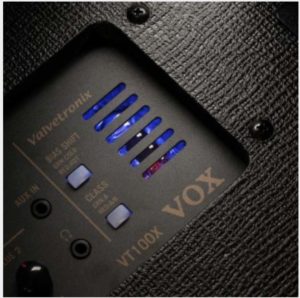
Are the Made In Mexico Fender Amps Any Good?
Fender’s tube amp line is built down in their Ensenada, Mexico factory. Are they any good? If you’ve played Fender’s standard line of guitars and basses that are built in that factory, then you know that they make a great guitar. But how are the amps?
While I’m a huge fan of hand-wired amplifiers, Fender amps with PCBs (printed circuit board) are well designed, and most importantly very quiet. They have the ground circuits down to a science, and you’ll have no problem plugging this thing in and getting a nice silent idle. Tube amps can be noisy beasts and there’s nothing worse than an amp that hums incessantly when a guitar is just plugged into it. You will not have that issue with Mexican made Fender amps.
That factory has been making Fender’s standard line for more than 25 years, and they’ve gotten very good at it. All of the stuff coming out of there is of the highest quality, and I’d be more than happy to pay for that and avoid the pricey tag of a “made in the USA” amplifier.
Does the Blues Jr. have a headphone jack?
The Blues Jr. does not have a headphone jack, and neither will any other tube amp. We’re out of the practice amp world, so if that’s what you’re looking for check out this post about the best first amp to buy which details some awesome practice amps with all sorts of effects, models, and yes a headphone jack.
But you may be wondering why don’t tube amps have headphone jacks?
Based on the power and output of the power section of the amp, the output transformer is putting out a specific impedance. In order to maximize the quality of sound of the amplifier, it’s important to match the impedance of the load (the speaker) with that of the output transformer. If there is a mismatch, then there will be a degradation in sound quality, and excess load may be put on the power section. Plugging headphones into a tube amp most likely will damage the output transformer and the power tubes.
For example, my personal favorite Sony MDR7506 Professional Large Diaphragm Headphone has an impedance of 63 Ohms while the Blues Jr output transformer typical outputs 8 Ohms. That difference is large enough to possibly cause damage to the amp.
Don’t plug headphones into a guitar amp unless there is a specific headphone jack labelled as such. You don’t want to damage your headphones, or the amp.
For more info on impedance and OT output go read this page from Aiken Amplification
Can I Plug a Microphone into the Blues Jr.?
While the Blues Jr. isn’t specifically voiced for a microphone, I’ve heard harmonica players plug a harp mic into a Blues Jr. and sound great. The lack of general midrange produces a great blues tone with a harmonica mic that doesn’t let too much bass muddy the sound.
I wouldn’t plug a vocal mic into the Blues Jr., but go ahead and try it out with a harmonica, especially if you’re going for that bluesy sound.
